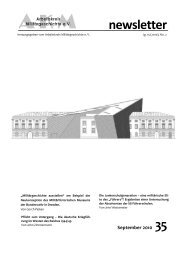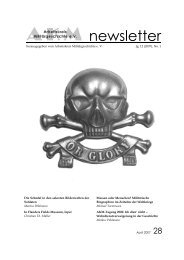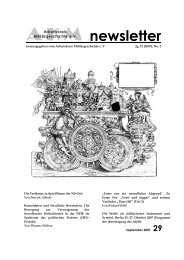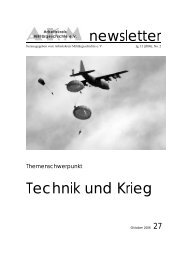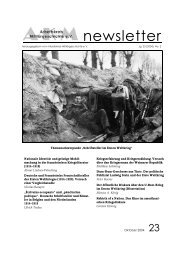Geschichte Erster Weltkrieg - Portal Militärgeschichte - Arbeitskreis ...
Geschichte Erster Weltkrieg - Portal Militärgeschichte - Arbeitskreis ...
Geschichte Erster Weltkrieg - Portal Militärgeschichte - Arbeitskreis ...
Sie wollen auch ein ePaper? Erhöhen Sie die Reichweite Ihrer Titel.
YUMPU macht aus Druck-PDFs automatisch weboptimierte ePaper, die Google liebt.
26 War and Society<br />
mobilization for war. They acted as local<br />
transmitters of the national propaganda efforts<br />
by adjusting the messages to local cultural<br />
codes. Mourning and remembrance served as<br />
prime examples of how local identities and<br />
national events interacted. Adam R. Seipp<br />
(University of North Carolina, Chapel Hill)<br />
compared the demobilization process in<br />
Munich and Manchester in 1918/19. Both cities<br />
serve as case-studies in a project that focuses on<br />
the new role of state and citizenship, the<br />
changed understanding of politics, and the way<br />
authorities coped with the general demand for<br />
“order” in the post World War I period. Both<br />
papers attempted to “make the picture more<br />
complex” by challenging established narratives<br />
on the national level, but were confronted with<br />
problems of contextualizing their findings and<br />
justifying the selection of their examples.<br />
In the fifth panel David J. Bielanski<br />
(University of Illinois, Urbana-Champaign)<br />
presented a paper on Weimar paramilitary<br />
violence and the cult of the dead in Germany<br />
after World War I. Bielanski explored the<br />
masculine features of the “new man” that were<br />
based on the experiences of the front soldiers<br />
and and revolved around concepts of duty and<br />
service to the nation. They were visible in<br />
paramilitary organizations such as the socialist<br />
Reichsbanner and the nationalist Stahlhelm.<br />
Violence was a key-element in the identity of<br />
their members; fights in the streets replaced the<br />
fight in the trenches. Those killed in these<br />
battles were easily incorporated within the cult<br />
of the dead.<br />
The papers of the sixth panel dealt with the<br />
relationship between intellectuals, science and<br />
war. James A. Good (Rice University) showed<br />
how the reception of German idealism – most<br />
notably the philosophy of G. W. F. Hegel – in<br />
America was influenced by wars. Steven P.<br />
Remy (Ohio State University) dealt with the<br />
University of Heidelberg in the Third Reich and<br />
disproved the “Heidelberg myth” of the<br />
universities as victims of the regime. Focusing<br />
on the activities of departments and professors<br />
during World War II, he showed that the<br />
regime could count on the support of its<br />
universities and research institutions through<br />
war-related publications, courses, and lectures<br />
as well as technological innovations, weapons<br />
research, “Raumforschung,” and medical<br />
services. The discussion of both papers raised<br />
broad questions of the relationship between<br />
intellectuals and society.<br />
The seventh panel brought together papers<br />
by Wendy Maxon (University of California, San<br />
Diego) and Monica A. Black (University of<br />
Virginia, Charlottesville). Wendy Maxon<br />
explored the topics of mechanization and<br />
bestialization in German culture after World<br />
War I. She focused on the works of artists such<br />
as Oskar Schlemmer, Rudolf Schlichter,<br />
Heinrich Davringhausen, and George Grosz.<br />
They were occupied with the effects that the<br />
industrialized slaugther had on the soldier’s<br />
body on the western front. Their disturbing<br />
images of robots and human Fleisch were<br />
contrasted by a new awareness of sports,<br />
conditioned bodies, and health in general.<br />
Monica A. Black presented her research project<br />
on perception of death among German soldiers<br />
during World War II. Based on the reading of<br />
letters from the front which are dominated by<br />
elements of the Christian narrative of suffering,<br />
death, judgement, and resurrection and<br />
victimization, she argued that religious<br />
convictions largely survived under the NSregime.<br />
The totalitarian ideology had not<br />
superseded Christianity, but on the eastern<br />
front the two coincided when the enemy was<br />
described as godless, anti-Christian, and bestial.<br />
The last panel dealt with German history<br />
after 1945. Andrew Oppenheimer (University<br />
of Chicago) discussed West German pacifism.<br />
The fate of the German Peace Society,<br />
relicensed in November 1945, illustrates the<br />
obstacles to a simple continuity in pacifist<br />
activism. In the Cold War, the society’s<br />
educational work could not be based on the<br />
Weimar-era ideals of anti-militarism. It adapted<br />
to general liberal-democratic values of the<br />
West, but continued to oppose rearmament and<br />
the integration of the Federal Republic into<br />
NATO. Kristin Rebien (Stanford University)<br />
presented her research on the Gruppe 47, the<br />
influential network of writers around the<br />
author Hans-Werner Richter. All the members<br />
of the group had been fighting in World War II<br />
and dealt with the war and its consequences in<br />
their writings. The discussion of both papers<br />
circled around various questions of political<br />
and cultural continuity and discontinuity after<br />
1945.




